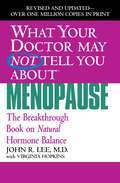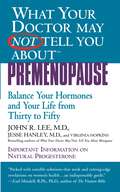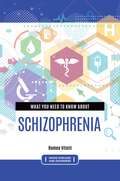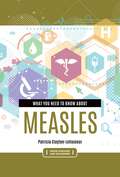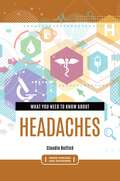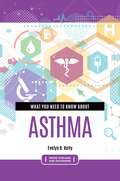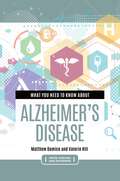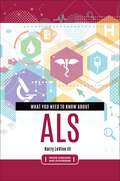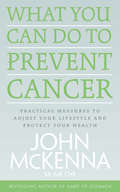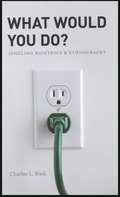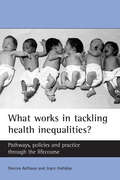- Table View
- List View
What's in the Syringe?: Principles of Early Integrated Palliative Care
by Juliet Jacobsen Vicki Jackson Joseph Greer Jennifer TemelWhat's in the Syringe? offers a succinct overview of the psychological skills of outpatient palliative care, teaching clinicians how to help patients live well and acknowledge end of life as patients meet five challenges of serious illness. It explores how to help patients develop prognostic awareness, through which they pair hopes and worries and see themselves with clarity and empathy. The book also teaches clinicians how to support patients' coping skills. As patients use these skills, they improve their quality of life and deepen their prognostic awareness, helping them make informed medical and personal decisions as they approach end of life. Illustrated, case-based chapters are organized from diagnosis to end of life and draw on two decades of research and clinical experience. Each chapter describes how palliative care and oncology clinicians can collaborate and explains the interpretive role of the palliative care clinician in helping the patient and oncologist understand each other. What's in the Syringe? is an essential resource for palliative care fellows, trainees, and clinicians, for oncologists, primary care clinicians, and medical students, and for all care providers working with patients facing serious illness.
What's Eating You?: People and Parasites
by Eugene H. KaplanIn What's Eating You? Eugene Kaplan recounts the true and harrowing tales of his adventures with parasites, and in the process introduces readers to the intimately interwoven lives of host and parasite. Kaplan has spent his life traveling the globe exploring oceans and jungles, and incidentally acquiring parasites in his gut. Here, he leads readers on an unforgettable journey into the bizarre yet oddly beautiful world of parasites. In a narrative that is by turns frightening, disgusting, and laugh-out-loud funny, Kaplan describes how drinking contaminated water can cause a three-foot-long worm to burst from your arm; how he "gave birth" to a parasite the size and thickness of a pencil while working in Israel; why you should never wave a dead snake in front of your privates; and why fleas are attracted to his wife. Kaplan tells stories about leeches feasting on soldiers in Vietnam; sea cucumbers with teeth in their anuses that seem to encourage the entry of symbiotic fish; the habits of parasites that cause dysentery, river blindness, and other horrifying diseases--and much, much more. Along the way, he explains the underlying science, including parasite evolution and host-parasite physiology. Informative, frequently lurid, and hugely entertaining, this beautifully illustrated book is a must-read for health-conscious travelers, and anyone who has ever wondered if they picked up a tapeworm from that last sushi dinner.
What's Eating You?: People and Parasites
by Eugene H. KaplanIn What's Eating You? Eugene Kaplan recounts the true and harrowing tales of his adventures with parasites, and in the process introduces readers to the intimately interwoven lives of host and parasite. Kaplan has spent his life traveling the globe exploring oceans and jungles, and incidentally acquiring parasites in his gut. Here, he leads readers on an unforgettable journey into the bizarre yet oddly beautiful world of parasites. In a narrative that is by turns frightening, disgusting, and laugh-out-loud funny, Kaplan describes how drinking contaminated water can cause a three-foot-long worm to burst from your arm; how he "gave birth" to a parasite the size and thickness of a pencil while working in Israel; why you should never wave a dead snake in front of your privates; and why fleas are attracted to his wife. Kaplan tells stories about leeches feasting on soldiers in Vietnam; sea cucumbers with teeth in their anuses that seem to encourage the entry of symbiotic fish; the habits of parasites that cause dysentery, river blindness, and other horrifying diseases--and much, much more. Along the way, he explains the underlying science, including parasite evolution and host-parasite physiology. Informative, frequently lurid, and hugely entertaining, this beautifully illustrated book is a must-read for health-conscious travelers, and anyone who has ever wondered if they picked up a tapeworm from that last sushi dinner.
What Your Doctor May Not Tell You About(TM) (TM) (TM) (TM) (TM) (TM) (TM) (TM) (TM) (TM) (TM) (TM) (TM) (TM) (TM) (TM) (TM) (TM) (TM) (TM) (TM) (TM) (TM) (TM) (TM) (TM) (TM) (TM) (TM) (TM) (TM) (TM): Menopause: The Breakthrough Book on Natural Progesterone
by Virginia Hopkins John R. LeeArguing that giving estrogen replacement therapy to women after menopause is medically the wrong thing to do, Lee suggests that natural progesterone can prevent most of the unpleasant side effects of menopause, including osteoporosis and weight gain.
What Your Doctor May Not Tell You About(TM) (TM) (TM) (TM) (TM) (TM) (TM) (TM): Premenopause: Balance Your Hormones and Your Life from Thirty to Fifty
by John R. Lee Jesse HanleyA safe, effective hormone balance program for women aged 30-50 suffering from premenopause syndrome. Restore and maintain gynecological health, sex drive, and energy.I'm too young for menopause. So why do I feel like this? Even if you're a decade or more away from menopause, your hormones may already be out of balance, usually caused by an excess of estrogen and a deficiency of progesterone. Over 50 million women experience premenopause symptoms, including:Unexplained, sudden weight gainSevere PMS, fatigue, irritability, and mood swingsLoss of libidoTender or lumpy breastsFibroids and endometriosisCold hands and feetVery heavy or light periodsOr other symptoms like infertility, memory loss, and migraines.Now Dr. John Lee-author of the groundbreaking What Your Doctor May Not Tell You About Menopause-teams up with women's health expert Jesse Hanley, M.D., to bring you a revolutionary nonprescription "Balance Program" with simple, safe, and natural solutions for premenopause.Learn how natural progesterone and changes to your diet and environment can balance your hormones, eliminate premenopausal symptoms, and make you feel better-all without surgery, antidepressants, or prescription hormones.
WHAT YOUR DOCTOR MAY NOT TELL YOU ABOUT (TM) (TM) (TM) (TM) (TM) (TM) (TM) (TM): FIBROMYALGIA: The Revolutionary Treatment That Can Reverse the Disease
by Claudia Craig Marek R. Paul St. AmandOver a decade ago, Dr. R. Paul St. Amand, an experienced endocrinologist and UCLA assistant clinical professor, published his protocol for reversing fibromyalgia based on nearly half a century of research. This book offers Dr. St. Amand's latest research on guaifenesin, an inexpensive, safe, an incresingly available medication that can help reverse the disease. The authors have seen symtpoms eliminated and normal quality of life restored in an astonishing 90 percent of pateints they treated with guaifenesin. Updated and revised with more patient anecdotes and a deeper understanding of symptoms, treatments, and results, readers will find: More information about the current treatment of fibromyalgia and what causes it New results from Dr. St. Amand's studies about the efficacy of guafenesin treatment Changes in disease protocol Discussion of pharmaceuticals in treatment--and much more
What Your Doctor May Not Tell You About(TM) (TM) (TM) (TM) (TM) (TM) (TM) (TM): Breast Cancer: How Hormone Balance Can Help Save Your Life
by John R. Lee David ZavaPart of the bestselling What Your Doctor May Not Tell You series, an informative, detailed guide to breast cancer, including treatment and prevention.Each year, over 40,000 women in the U.S. die from breast cancer. With statistics rising, conventional methods of treatment are simply not working, and in some cases may even be harmful. Now, Drs. Lee and Zava explain the potentially life-saving facts, such as: likely sources for the increase in breast cancer, including environment, excessive estrogen, progesterone imbalance, diet, and the dangers associated with traditional hormone replacement methods. Readers will learn strategies for lowering their risk and preventing this devastating disease through a revolutionary hormone balance program.
WHAT YOUR DOCTOR MAY NOT TELL YOU ABOUT (TM): CHILDREN'S VACCINATIONS
by Stephanie Cave Deborah MitchellThis is an essential guide for parents about vaccinations. Dr. Stephanie Cave explains their pros and cons and the book provides information to help parents make a knowledgeable, responsible choice about vaccinating their children.
What Your Doctor May Not Tell You About Fibromyalgia: The Revolutionary Treatment That Can Reverse the Disease
by R. Paul St. Amand Claudia Craig MarekWhat Your Doctor May Not Tell You About Fibromyalgia is the only protocol that actually treat the condition, reduces drug dependency, and offer an actual cure. Most patients with fibromyalgia are on as astonishing array of medications--sometimes taking over 10 different medications and supplements a day to treat symptoms ranging from muscle pain and fatigue to hypoglycemia, IBS, and chronic candidiasis--and they still can't control their pain. This fourth edition of the book goes deeper into understanding the disease and the early intervention options that are available. With special attention paid to fatigue and pain management protocols, Dr. St. Armand goes into great detail about the big issues surrounding fibromyalgia today, including:A close look at supplements, including CBS oil--an unregulated market without the same scientific rigor as most medicationsGuaifenesin as a drug that does work, eliminating symptoms and restoring normal life to an astonishing 90 percent of the fibromyalgia sufferersA discussion of pharmaceuticals in treatment, and why "medical Band-Aids" won't treat the disease changes in disease protocoldiscussion of pharmaceuticals in treatment
What You Think ADD/ADHD Is, It Isn't: Symptoms and Neuropsychological Testing Through Time
by Barbara C. FisherADD/ADHD is not as easily diagnosed or clear-cut as many believe; in fact it very often acts as a masking agent for other underlying, contributing disorders. It‘s important that we understand ADD/ADHD better. What You Think ADD/ADHD Is, It Isn�t: Symptoms and Neuropsychological Testing Through Time is the culmination of the author‘s years of resear
What You Need to Know about Schizophrenia (Inside Diseases and Disorders)
by Romeo VitelliAlthough often depicted as aggressive and unpredictable in movies, people with schizophrenia are actually far more likely to be the victims of violence than perpetrators of it. This book sheds light on the realities of this often misunderstood mental illness.Schizophrenia is a mental disorder characterized by delusions, hallucinations, and disordered thoughts and behaviors. Although schizophrenia requires lifelong treatment, early intervention can help individuals effectively manage their symptoms. Even so, it can be a challenging condition to navigate for both the patient and their loved ones.What You Need to Know about Schizophrenia is part of Greenwood's Inside Diseases and Disorders series. This series profiles a variety of physical and psychological conditions, distilling and consolidating vast collections of scientific knowledge into concise, readable volumes. A list of "top 10" essential questions begins each book, providing quick-access answers to readers' most pressing concerns. The text follows a standardized, easy-to-navigate structure, with each chapter exploring a particular facet of the topic. In addition to covering such basics as causes, signs and symptoms, diagnosis, and treatment options, books in this series delve into issues that are less commonly addressed but still critically important, such as effects on loved ones and caregivers. Case illustrations highlight key themes discussed in the book and are accompanied by insightful analyses and recommendations.
What You Need to Know about Schizophrenia (Inside Diseases and Disorders)
by Romeo VitelliAlthough often depicted as aggressive and unpredictable in movies, people with schizophrenia are actually far more likely to be the victims of violence than perpetrators of it. This book sheds light on the realities of this often misunderstood mental illness.Schizophrenia is a mental disorder characterized by delusions, hallucinations, and disordered thoughts and behaviors. Although schizophrenia requires lifelong treatment, early intervention can help individuals effectively manage their symptoms. Even so, it can be a challenging condition to navigate for both the patient and their loved ones.What You Need to Know about Schizophrenia is part of Greenwood's Inside Diseases and Disorders series. This series profiles a variety of physical and psychological conditions, distilling and consolidating vast collections of scientific knowledge into concise, readable volumes. A list of "top 10" essential questions begins each book, providing quick-access answers to readers' most pressing concerns. The text follows a standardized, easy-to-navigate structure, with each chapter exploring a particular facet of the topic. In addition to covering such basics as causes, signs and symptoms, diagnosis, and treatment options, books in this series delve into issues that are less commonly addressed but still critically important, such as effects on loved ones and caregivers. Case illustrations highlight key themes discussed in the book and are accompanied by insightful analyses and recommendations.
What You Need to Know about Measles (Inside Diseases and Disorders)
by Patricia Clayton-LeVasseurAlthough measles is a preventable disease, today cases are on the rise in the United States because of falling vaccination rates. This book provides a broad introduction to this once widespread and still potentially very dangerous viral infection.Measles is a highly contagious viral infection that can cause serious, even life-threatening, complications. Although the MMR vaccine is effective at preventing measles, the rise of anti-vaccination sentiment in the United States has many experts concerned that measles may once again become a significant public health threat.What You Need to Know about Measles is part of Greenwood's Inside Diseases and Disorders series. This series profiles a variety of physical and psychological conditions, distilling and consolidating vast collections of scientific knowledge into concise, readable volumes. A list of "top 10" essential questions begins each book, providing quick-access answers to readers' most pressing concerns. The text follows a standardized, easy-to-navigate structure, with each chapter exploring a particular facet of the topic. In addition to covering such basics as causes, signs and symptoms, diagnosis, and treatment options, books in this series delve into issues that are less commonly addressed but still critically important, such as effects on loved ones and caregivers. Case illustrations highlight key themes discussed in the book and are accompanied by insightful analyses and recommendations.
What You Need to Know about Measles (Inside Diseases and Disorders)
by Patricia Clayton-LeVasseurAlthough measles is a preventable disease, today cases are on the rise in the United States because of falling vaccination rates. This book provides a broad introduction to this once widespread and still potentially very dangerous viral infection.Measles is a highly contagious viral infection that can cause serious, even life-threatening, complications. Although the MMR vaccine is effective at preventing measles, the rise of anti-vaccination sentiment in the United States has many experts concerned that measles may once again become a significant public health threat.What You Need to Know about Measles is part of Greenwood's Inside Diseases and Disorders series. This series profiles a variety of physical and psychological conditions, distilling and consolidating vast collections of scientific knowledge into concise, readable volumes. A list of "top 10" essential questions begins each book, providing quick-access answers to readers' most pressing concerns. The text follows a standardized, easy-to-navigate structure, with each chapter exploring a particular facet of the topic. In addition to covering such basics as causes, signs and symptoms, diagnosis, and treatment options, books in this series delve into issues that are less commonly addressed but still critically important, such as effects on loved ones and caregivers. Case illustrations highlight key themes discussed in the book and are accompanied by insightful analyses and recommendations.
What You Need to Know about Headaches (Inside Diseases and Disorders)
by Claudio ButticèThere are numerous types of headaches, each with a unique cause, pain profile, and set of treatment options. This book offers readers a broad introduction to this common, yet often misunderstood, group of conditions.What exactly is going on in your body during a headache? How can they be prevented or managed? How can you tell if your splitting headache is actually a brain tumor? This book provides the answers to these and many other questions.What You Need to Know about Headaches is the latest volume in Greenwood's Inside Diseases and Disorders series. This series profiles a variety of physical and psychological conditions, distilling and consolidating vast collections of scientific knowledge into concise, readable volumes. A list of "top 10" essential questions begins each book, providing quick-access answers to readers' most pressing concerns. The text follows a standardized, easy-to-navigate structure, with each chapter exploring a particular facet of the topic. In addition to covering such basics as causes, signs and symptoms, diagnosis, and treatment options, books in this series delve into issues that are less commonly addressed but still critically important, such as effects on loved ones and caregivers. Case illustrations highlight key themes discussed in the book and are accompanied by insightful analyses and recommendations.
What You Need to Know about Headaches (Inside Diseases and Disorders)
by Claudio ButticèThere are numerous types of headaches, each with a unique cause, pain profile, and set of treatment options. This book offers readers a broad introduction to this common, yet often misunderstood, group of conditions.What exactly is going on in your body during a headache? How can they be prevented or managed? How can you tell if your splitting headache is actually a brain tumor? This book provides the answers to these and many other questions.What You Need to Know about Headaches is the latest volume in Greenwood's Inside Diseases and Disorders series. This series profiles a variety of physical and psychological conditions, distilling and consolidating vast collections of scientific knowledge into concise, readable volumes. A list of "top 10" essential questions begins each book, providing quick-access answers to readers' most pressing concerns. The text follows a standardized, easy-to-navigate structure, with each chapter exploring a particular facet of the topic. In addition to covering such basics as causes, signs and symptoms, diagnosis, and treatment options, books in this series delve into issues that are less commonly addressed but still critically important, such as effects on loved ones and caregivers. Case illustrations highlight key themes discussed in the book and are accompanied by insightful analyses and recommendations.
What You Need to Know about Asthma (Inside Diseases and Disorders)
by Evelyn B. KellyWhile some individuals with asthma consider the condition only a minor nuisance, for others it significantly interferes with daily activities and may even be life-threatening. This book offers readers a broad introduction to this common respiratory issue.Asthma is a respiratory condition marked by spasms, swelling, and excess mucus production in the bronchial passages of the lungs. This triggers coughing, wheezing, chest tightness, and shortness of breath. While asthma can usually be managed with medications and avoidance of certain triggers, it's a serious—potentially deadly—chronic disease.What You Need to Know about Asthma is part of Greenwood's Inside Diseases and Disorders series. This series profiles a variety of physical and psychological conditions, distilling and consolidating vast collections of scientific knowledge into concise, readable volumes. A list of "top 10" essential questions begins each book, providing quick-access answers to readers' most pressing concerns. The text follows a standardized, easy-to-navigate structure, with each chapter exploring a particular facet of the topic. In addition to covering such basics as causes, signs and symptoms, diagnosis, and treatment options, books in this series delve into issues that are less commonly addressed but still critically important, such as effects on loved ones and caregivers. Case illustrations highlight key themes discussed in the book and are accompanied by insightful analyses and recommendations.
What You Need to Know about Asthma (Inside Diseases and Disorders)
by Evelyn B. KellyWhile some individuals with asthma consider the condition only a minor nuisance, for others it significantly interferes with daily activities and may even be life-threatening. This book offers readers a broad introduction to this common respiratory issue.Asthma is a respiratory condition marked by spasms, swelling, and excess mucus production in the bronchial passages of the lungs. This triggers coughing, wheezing, chest tightness, and shortness of breath. While asthma can usually be managed with medications and avoidance of certain triggers, it's a serious—potentially deadly—chronic disease.What You Need to Know about Asthma is part of Greenwood's Inside Diseases and Disorders series. This series profiles a variety of physical and psychological conditions, distilling and consolidating vast collections of scientific knowledge into concise, readable volumes. A list of "top 10" essential questions begins each book, providing quick-access answers to readers' most pressing concerns. The text follows a standardized, easy-to-navigate structure, with each chapter exploring a particular facet of the topic. In addition to covering such basics as causes, signs and symptoms, diagnosis, and treatment options, books in this series delve into issues that are less commonly addressed but still critically important, such as effects on loved ones and caregivers. Case illustrations highlight key themes discussed in the book and are accompanied by insightful analyses and recommendations.
What You Need to Know about Alzheimer's Disease (Inside Diseases and Disorders)
by Matthew Domico Valerie HillThis book provides readers with the information they need to better understand Alzheimer's disease. Written in easy-to-understand language, it is aimed at those who may have a parent, grandparent, or other loved one struggling with this condition.Alzheimer's disease is a neurodegenerative disorder that causes problems with thinking, memory, and behavior. Such symptoms as memory loss usually develop slowly but get worse over time, eventually becoming severe enough to interfere with daily activities and bodily functions.What You Need to Know about Alzheimer's Disease is part of Greenwood's Inside Diseases and Disorders series. This series profiles a variety of physical and psychological conditions, distilling and consolidating vast collections of scientific knowledge into concise, readable volumes. A list of "Top 10" essential questions begins each book, providing quick-access answers to readers' most pressing concerns. The text follows a standardized, easily navigable structure, with each chapter exploring a particular facet of the topic. In addition to covering such basics as causes, signs and symptoms, diagnosis, and treatment options, books in this series delve into issues that are less commonly addressed but still critically important, such as effects on loved ones and caregivers. Case illustrations highlight key themes discussed in the book and are accompanied by insightful analyses and recommendations.
What You Need to Know about Alzheimer's Disease (Inside Diseases and Disorders)
by Matthew Domico Valerie HillThis book provides readers with the information they need to better understand Alzheimer's disease. Written in easy-to-understand language, it is aimed at those who may have a parent, grandparent, or other loved one struggling with this condition.Alzheimer's disease is a neurodegenerative disorder that causes problems with thinking, memory, and behavior. Such symptoms as memory loss usually develop slowly but get worse over time, eventually becoming severe enough to interfere with daily activities and bodily functions.What You Need to Know about Alzheimer's Disease is part of Greenwood's Inside Diseases and Disorders series. This series profiles a variety of physical and psychological conditions, distilling and consolidating vast collections of scientific knowledge into concise, readable volumes. A list of "Top 10" essential questions begins each book, providing quick-access answers to readers' most pressing concerns. The text follows a standardized, easily navigable structure, with each chapter exploring a particular facet of the topic. In addition to covering such basics as causes, signs and symptoms, diagnosis, and treatment options, books in this series delve into issues that are less commonly addressed but still critically important, such as effects on loved ones and caregivers. Case illustrations highlight key themes discussed in the book and are accompanied by insightful analyses and recommendations.
What You Need to Know about ALS (Inside Diseases and Disorders)
by Harry LeVine IIIThis book offers an accessibly written introduction to ALS, focusing on the topics that matter most to anyone whose life has been affected—directly or indirectly—by this condition.Amyotrophic lateral sclerosis (ALS) or Lou Gehrig's disease, is a neurodegenerative disease that affects the motor neurons that drive voluntary movement. Those diagnosed with ALS experience difficulty moving and speaking and, as the condition worsens, difficulty swallowing and breathing. Beyond this definition, however, what do those affected by ALS need to know?What You Need to Know about ALS is a part of Greenwood's Inside Diseases and Disorders series. This series profiles a variety of physical and psychological conditions, and distills vast collections of scientific knowledge into concise, readable volumes. A list of "Top 10" essential questions begins each book, providing quick-access answers to readers' concerns. The text follows a standardized structure, with each chapter exploring a particular facet of the topic. In addition to covering causes, signs and symptoms, diagnosis, and treatment options, books in this series delve into issues that are less commonly addressed but still critical to understand, such as effects on loved ones and caregivers. Case illustrations highlight key themes discussed in the book and are accompanied by insightful analyses and recommendations.
What You Need to Know about ALS (Inside Diseases and Disorders)
by Harry LeVine IIIThis book offers an accessibly written introduction to ALS, focusing on the topics that matter most to anyone whose life has been affected—directly or indirectly—by this condition.Amyotrophic lateral sclerosis (ALS) or Lou Gehrig's disease, is a neurodegenerative disease that affects the motor neurons that drive voluntary movement. Those diagnosed with ALS experience difficulty moving and speaking and, as the condition worsens, difficulty swallowing and breathing. Beyond this definition, however, what do those affected by ALS need to know?What You Need to Know about ALS is a part of Greenwood's Inside Diseases and Disorders series. This series profiles a variety of physical and psychological conditions, and distills vast collections of scientific knowledge into concise, readable volumes. A list of "Top 10" essential questions begins each book, providing quick-access answers to readers' concerns. The text follows a standardized structure, with each chapter exploring a particular facet of the topic. In addition to covering causes, signs and symptoms, diagnosis, and treatment options, books in this series delve into issues that are less commonly addressed but still critical to understand, such as effects on loved ones and caregivers. Case illustrations highlight key themes discussed in the book and are accompanied by insightful analyses and recommendations.
What You Can Do to Prevent Cancer: Practical Measures to Adjust Your Lifestyle and Protect Your Health
by Dr John McKennaDid you know that one in three people in Ireland will develop cancer during their life?Or that an average of 30,000 new cases of cancer are diagnosed in Ireland each year? These are frightening statistics, but there are measures you can take to protect yourself and reduce your chances of developing the disease.In What You Can Do to Prevent Cancer, bestselling author John McKenna provides the knowledge you need to take control of your health. He explores the pivotal role played by your environment, the importance of a healthy immune system, the dangers of stress and advice on which foods you should eat and which you should eliminate from your diet to protect yourself and your health.
What Would You Do?: Juggling Bioethics and Ethnography
by Charles L. BoskIn hospital rooms across the country, doctors, nurses, patients, and their families grapple with questions of life and death. Recently, they have been joined at the bedside by a new group of professional experts, bioethicists, whose presence raises a host of urgent questions. How has bioethics evolved into a legitimate specialty? When is such expertise necessary? How do bioethicists make their decisions? And whose interests do they serve? Renowned sociologist Charles L. Bosk has been observing medical care for thirty-five years. In What Would You Do? he brings his extensive experience to bear on these questions while reflecting on the ethical dilemmas that his own ethnographic research among surgeons and genetic counselors has provoked. Bosk considers whether the consent given to ethnographers by their subjects can ever be fully voluntary and informed. He questions whether promises of confidentiality and anonymity can or should be made. And he wonders if social scientists overestimate the benefits of their work while downplaying the risks. Vital for practitioners of both the newly prominent field of bioethics and the long-established craft of ethnography, What Would You Do? will also engross anyone concerned with how our society addresses difficult health care issues.
What works in tackling health inequalities?: Pathways, policies and practice through the lifecourse (Studies in Poverty, Inequality and Social Exclusion series)
by Sheena Asthana Joyce HallidayIn recent years, tackling health inequalities has become a key policy objective in the UK. However, doubts remain about how best to translate broad policy recommendations into practice. One key area of uncertainty concerns the role of local level initiatives. This book identifies the key targets for intervention through a detailed exploration of the pathways and processes that give rise to health inequalities across the lifecourse. It sets this against an examination of both local practice and the national policy context, to establish what works in health inequalities policy, how and why. Authoritative yet accessible, the book provides a comprehensive account of theory, policy and practice. It spans the lifecourse from the early years to old age and explores the links between biological, psychological, social, educational and economic factors and a range of health outcomes. In addition it describes key policy initiatives, assesses research evidence of 'what works' and examines the limitations of the existing evidence base and highlights key areas of debate. What works in tackling health inequalities? is essential reading for academics and students in medical sociology, social psychology, social policy and public health, and for policy makers and practitioners working in public health and social exclusion.


